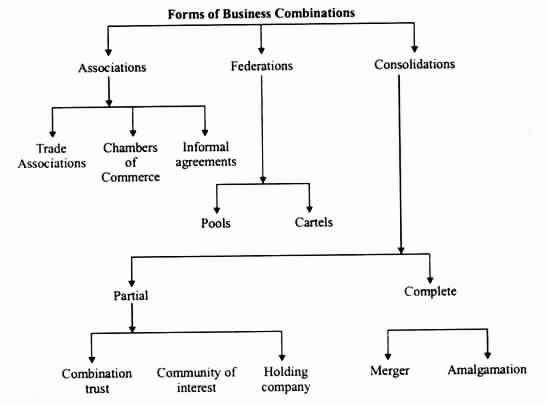Business Combination Types and Forms
25/01/2022 0 By indiafreenotesBusiness combinations are of the following types:
(i) Horizontal Combinations.
(ii) Vertical Combinations.
(iii) Lateral or Allied Combinations:
Lateral combination refers to the combination of those firms which manufacture different kinds of products; though they are allied in some way.
Lateral combination may be:
(a) Convergent lateral combination:
In convergent lateral combination, different industrial units which supply raw-materials to a major firm, combine together with the major firm. The best illustration is found in a printing press, which may combine with units engaged in supply of paper, ink, types, cardboard, printing machinery etc.
(b) Divergent lateral combination:
Divergent lateral integration takes place when a major firm supplies its product to other combing firms, which use it as their raw material. The best example of such combination may be found in a steel mill which supplies steel to a number of allied concerns for the manufacture of a variety of products like tubing, wires, nails, machinery, locomotives etc.
(iv) Diagonal (or Service) Combinations:
This type of combination takes place when a unit providing essential auxiliary goods / services to an industry is combined with a unit operating in the main line of production. Thus, if an industrial enterprise combines with a repairs workshop for maintaining tools and machines in good order; it will be effecting diagonal combination.
(v) Circular (or Mixed) Combinations:
When firms engaged in the manufacture of different types of products join together; it is known as circular or mixed combination. For example, if a sugar mill combines with a steel works and a cement factory; the result is a mixed combination.
Forms of Business Combinations:
By the phrase ‘forms of combinations’, we mean the degree of combination, among the combining business units.
According to Haney, combinations may take the following forms, depending on the degree or fusion among combining firms:
(I) Associations:
(i) Trade associations
(ii) Chambers of commerce
(iii) Informal agreements
(II) Federations:
(i) Pools
(ii) Cartels
(III) Consolidations; Partial and Complete:
(а) Partial Consolidations:
(i) Combination trusts
(ii) Community of interest
(iii) Holding company
(b) Complete Consolidations:
(i) Merger
(ii) Amalgamation
The following chart depicts the above forms of business combinations:

Share this:
- Click to share on Twitter (Opens in new window)
- Click to share on Facebook (Opens in new window)
- Click to share on WhatsApp (Opens in new window)
- Click to share on Telegram (Opens in new window)
- Click to email a link to a friend (Opens in new window)
- Click to share on LinkedIn (Opens in new window)
- Click to share on Reddit (Opens in new window)
- Click to share on Pocket (Opens in new window)
- Click to share on Pinterest (Opens in new window)
- More